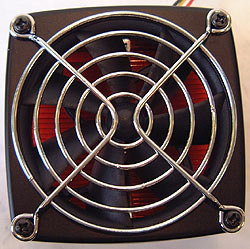|
Coolsonic CS1672A From All
Angles |
 |
The Fan: The heatsink uses what the
manufacturer Kai-Way term aa "top performance" Tip-Magnetic Drive fan
YS-Tech.
The fan spins at
about 5600 RPM, and draws about 0.3A of power. TMD fans as they
care commonly called are vastly superior in terms of delivering airflow uniform airflow. Typical
fans have a dead spot just below the motor which TMD fans
are free from. The fan is protected by a fan grill and
connects via a 3-pin connector which also supports RPM monitoring. |
 |
Top: It is really nice to see that the tip of
every copper fin is razor sharp - meaning that air from the fan will
have an easier time entering the fins all the way down. Square tipped fins
can stall air as there is generally more resistance to it passing.
The copper skived fins are 0.45mm thick which
is a little more than we usually see (0.3mm). The fan shroud keeps the TMD fan 6mm above the tips
of the copper fins. The clip has no notch to keep if from sliding around on the
heatsink. |
 |
Side
A: From the side we can see that
there are a total of 34 fins spaced
1.30mm apart. The CS1672A is not the highest density Skive heatsink on the market, but
has a nice balance to it. The copper base is 4mm thick,
and 60mm in width. Each fin is about 22mm in height. The fan shroud is copper
plated aluminum.
|
 |
Side B:
The fan
shroud is simply screwed onto the copper skive portion of the heatsink and
the TMD fan is subsequently attached with machine screws. The clip is
tool based, so you will need to find a flat head screw driver before installing the CS1672A. As we mentioned before, there
is no tab at the fulcrum of the clip to prevent the mass of the
heatsink from sliding a little after installation. The two sets of skived fins
are 32mm in width. The opening for the clip
is 6mm. |
 |
Heatsink Base:
From this angle we caught all the sanding marks so
the base looks worse than it actually is. Coolsonic have machined the base and then
given it a light sanding. The copper is pretty flat, and nice and smooth. The area
where the silicon core makes contact with the heatsink is generally flat, but not
perfectly so. |


